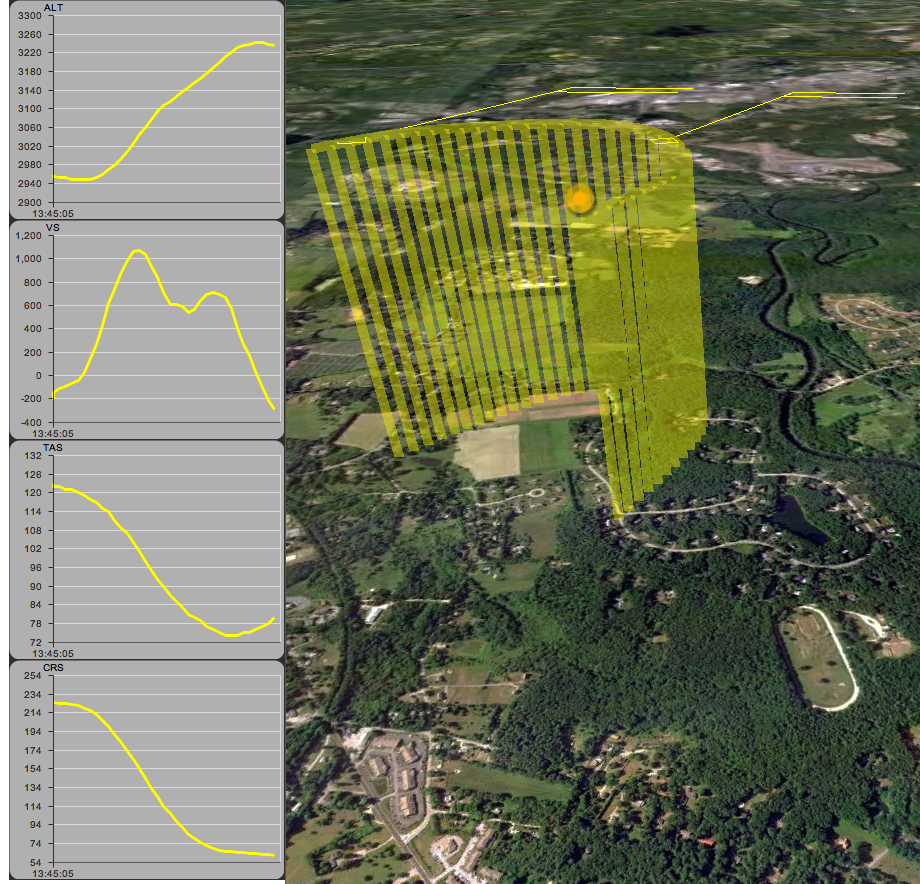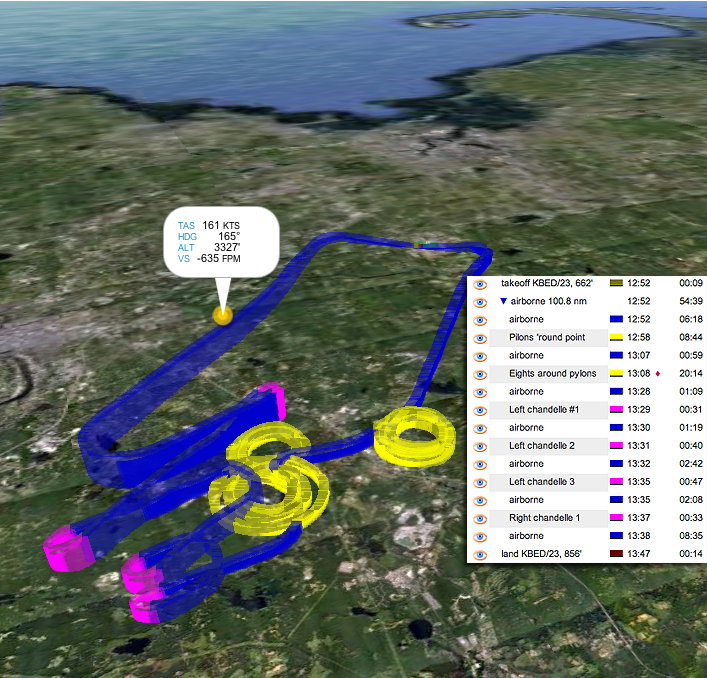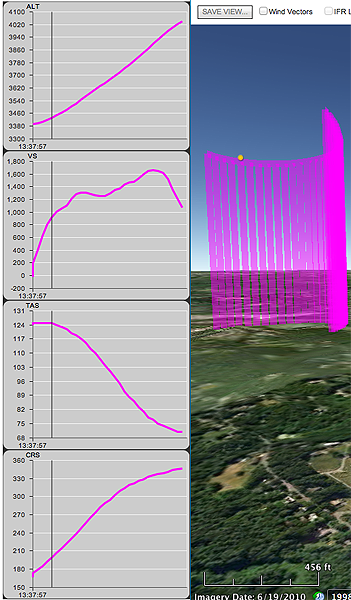Two of my kids, my wife and I went last night for a birthday dinner in a cute restaurant in JP (a Boston neighborhood). Each table had a real candle. I was thankful for that – I don’t like the fake electric candles that twinkle like the real thing, and send a message that it’s better to be safe than romantic.
The food was good, the wine was good, and the conversation lively. At one point I wanted to share what I’ve been doing in the air this week. On Monday I had a lesson with my CFI, John, and on Tuesday and Wednesday I practiced solo.
So I asked: imagine you are flying in a canyon, and there are magnificent mountains on your two sides. You are flying low, and the view is unbelievable: a river flows in the canyon, reflecting the blue sky with occasional white clouds, there is a herd of caribou drinking from a pond, the mountains above you are snow-capped, and there are picturesque houses with red shingles here and there, their chimneys sending a plum of smoke to the clean air.
I could almost hear the thoughts of my kids: OK, dad, just push that fast-forward button, get to the question already.
I said: the canyon gets narrower and then, as you make a turn you see in front of you a huge mountain. The canyon is closed! It’s what pilots call a Boxed Canyon. You are about to crash into the mountain. What do you do? Your plane is too weak to climb steeply over the mountain. And you know that if you attempt to turn back, your turn radius is such that you would hit the side of the canyon.
The gravity of the moment, the despair of the caribou-admiring pilot who may never see a runway again, prompted everybody to seek a solution. Unless we quickly find a solution, the pilot’s day would be ruined, not to mention the fate of a poor mountain goat which is in the flight path of his PA-28R-201.
Well, any pilot who trained for Commercial rating knows the answer. He needs to pull a Chandelle (candle in French). It’s a 180° turn combined with a climb, so the turn radius is very small. The waitress looked at us with puzzlement as we waved our hand in a simulated flight, exploring the intricacies of the maneuver. She came to ask if everything was OK. To demonstrate the sincerity of her question, she poured some more wine into the pilots’ glasses, thus significantly reducing our collective bottle-to-throttle time.
 At home, I used CloudAhoy to analyze one of my chandells. I chose the very first chandelle I did that day, where I turned to the left. As a novice Chandellier, I find left chandelles more challenging than right ones, because I need to be much more precise with the rudder. I clicked the “+” sign on the segments list and defined a new user-segment called Chandelle. I painted it yellow. Then I unselected all the segments, selected only the new Chandelle segment, zoomed and panned to see it from the side, and selected four flight profiles.
At home, I used CloudAhoy to analyze one of my chandells. I chose the very first chandelle I did that day, where I turned to the left. As a novice Chandellier, I find left chandelles more challenging than right ones, because I need to be much more precise with the rudder. I clicked the “+” sign on the segments list and defined a new user-segment called Chandelle. I painted it yellow. Then I unselected all the segments, selected only the new Chandelle segment, zoomed and panned to see it from the side, and selected four flight profiles.
How well did I do? This might be somewhat uncharted territory, I know of no analytical discussion of a chandelle with graphs. But looking at my performance, I was far from being happy.
To begin with, I started the maneuver at 122 knots. That’s Va which is too high, given that I was the only person in the cockpit. Well, in my defense I can say that the renter before me topped-off the fuel instead of what we normally do in the Arrow, which is fill to the tabs, so the airplane felt as if it carried two people.
I ended the maneuver at 74 knots. Not good! At the end of the turn I need to be near stall, so I was too fast. This means that I did not convert the max amount kinetic energy to potential energy, and my turn radius must have been larger than optimal. I turned on the display of wind vectors; it showed that I started the maneuver with head wind of 20 knots, and ended it with tail wind of the same magnitude. I think that the wind had no effect on the turn radius.
Next I checked the course. The maneuver was started at 225° and ended at 65°. Now, that’s pathetic: only 160°. The poor pilot would have been smeared onto the left side of the canyon. But I did like the smoothness of the turn: the turn rate seemed to be have been pretty constant.
How did I do on the altitude? I gained about 290’. Is that good or bad? I don’t know, I will have to ask John or compare it with other chandelles.
Lastly, I looked at the vertical speed. That’s probably most telling about the proficiency level of the pilot, me, on this maneuver. I think (but not sure) that an ideal chandelle should have a VS graph that looks trapezoid: quickly raising to a plateau (of how much? Maybe 800 feet/minute or so in the Arrow if the air is cool?), then quickly decreasing to zero as I roll out.
The vertical speed graph reminded me of one of the first drawings in The Little Prince. That’s appropriate: the late Antoine de Saint-Exupéry was not only a Frenchman who could pronounce Chandelle the way it is meant to be pronounced, but he was also an aviator who could probably fly a perfect chandelle even if he drank a bottle of Bordeaux immediately before takeoff. The graph tells me that I pulled too hard on the yoke at the beginning of the turn, then eased the pressure too much, then decide to pull again. Kinda like my flairs early on in my flight training, when I pulsated the yoke trying to get the plane on the ground.
The one piece of information that is missing is where the ball was during the chandelle. How coordinated was the turn? I need to think whether the four graphs can provide some information about the plane’s coordination. My gut feel is that they can.
My next lesson with John is on Monday. I need to analyze a chandelle which he likes, if there will be one, and use it as a golden reference.
The main dishes were consumed, the empty plates collected, and I used the table’s candle to help me read the desert menu. The FAA makes me wear glasses when I fly, but no one says I need to bring glasses to a restaurant. I thought that the desert menu was a bit disappointing compared to the rest of the meal, which is OK with me because I don’t typically order deserts anyway. Still I would rather have the deserts that I don’t order be first-class. The waitress brought the deserts that my kids ordered, tried to pour more wine, discovered that the bottle is empty, and smiled with satisfaction like a mother whose baby had just finished her bottled meal. She then gave me a spoon, so I can sample deserts or at least be cleared for the option.
We will definitely come back to this restaurant.


